 By BRUCE WARREN
By BRUCE WARRENIf you didn’t see the announcement for the Parks and Recreation Board meeting April 13 regarding a proposal for a “Bicycle Flow Trail”, or if you saw it and thought it wasn’t important to you because you aren’t a bicyclist, or you are a bicyclist and thought any bike trail is a good trail, I’m here to tell you that you should pay attention to this proposal. It will affect the entire community and has some ramifications that may raise some alarm in your mind.
There was another County meeting regarding the bicycle flow trail April 26, at Fuller Lodge. The Parks and Recreation Board calls these “public” meetings, but I saw no announcements of this meeting. I only heard about it because someone forwarded an email to me announcing the meeting. It had been sent to a select list, mostly the people and groups who are proponents of this flow trail. If you read this article, and are concerned about the proposal, you should speak up.
To put my comments in context, my house backs onto the Homestead Crossing Trailhead, and I spend a lot of time in the canyons of Los Alamos, both hiking and mountain biking. This article is the first of two planned articles about the bicycle flow trail and discusses issues that arise from placing this trail in one of our canyons. The second article will deal with ways the County could increase the interest in our existing network of trails, rather than building new ones. The flow trail project should not be confused with the urban bike trails that the County is proposing for the Townsite, which I strongly support.
WHAT IS A BICYCLE FLOW TRAIL?
According to the International Mountain Bicycling Association (IMBA), this is the official definition of a flow trail:
Flow Trails take mountain bikers on a terrain-induced roller coaster experience, with little pedaling and braking necessary. This style of trail typically contains features like banked turns, rolling terrain, various types of jumps, and consistent and predictable surfaces. Conspicuously absent are abrupt corners or unforeseen obstacles.
In other words, something more akin to a carnival ride than a bicycle ride through nature. Still that sounds like it might be fun for some bicyclists. Flow trails are wide, with a smooth dirt surface. They are restricted to bicycles only and traffic is only allowed downhill. You cannot walk on them, ride a horse on them, or ride them uphill. Since they are one-way, some way of getting the riders back to their cars must be provided. Most flow trails are built on ski areas and are lift-served. The trail proposed for Los Alamos would end at the sewage plant gate by the highway, and would require some kind of shuttle service. Flow trails typically incorporate “features” which are jumps, rollers, etc. In order to accommodate skill levels from beginner to expert, wherever these features are located, the trail would widen to allow lower level riders to avoid the features, making the trail even wider in these areas.
So what’s the big deal? The big deal is what has to happen in order to construct a flow trail, its effect on the environment, its cost, its impact on the lifestyle of the community, and its effect on others trying to enjoy our natural environment, such as hikers or equestrians. I sent an e-mail on April 17 to Eric Peterson, the County’s Open Space Manager, requesting more information on the routes of these trails, and more on the pros and cons he mentioned at the meeting, but have to date received no reply. I also did a search for “bicycle flow trail” on the County website and got nothing relating to this proposal, so my information is based on what I heard at the meeting on April 13 and what I could find on the Web. So here’s what I’ve discovered so far.
THE COUNTY PROPOSAL
According to the presentations given at the April 13 meeting, the County Council has “earmarked” $500,000 for the construction of a bicycle flow trail from the top of the Pajarito Ski Area to the bottom of Pueblo Canyon, ending at the sewage plant gate just west of the “Y” on the highway. In addition, $50,000 of that amount is to be used to construct a “pilot project”, which would be a flow trail in one of two locations:
- The Bayo Canyon Trail, from the Barranca/North Mesa roundabout to the sewage plant gate; or
- From the golf course down Walnut Canyon to the bottom of Pueblo Canyon and then to the sewage plant gate.
CONSTRUCTION OF FLOW TRAILS
The ideal grade for a flow trail is 6-7.5 percent. That translates to 300-400 feet elevation drop in 1 mile of trail. To construct a flow trail from the top of the chair lift at the ski hill to the parking lot (about 1000 feet drop) would require 2.5-3.5 miles of trail. To build one from the golf course to the bottom of Pueblo canyon (a drop of close to 300 feet) would require nearly a mile of trail, almost double the length of Walnut Canyon Road that currently gives that access. Flow trails also take up more room because they can’t have the classic switchback design with sharp turns, but must instead have large radius turns with banking and berms. That’s a lot of dirt to move.
Flow trails are built using earth-moving machinery, rather than the hand-building typically used for single-track trails. They also are wider than traditional single-track trails, and require the construction of features. In our canyons, this would mean bulldozing ledges into cliff edges, cutting and filling to level out the terrain, and the use of bridges to span drainages. If you take a walk on Bayo Canyon Trail or Walnut Canyon Trail and road, you will immediately see some of the problems with constructing such a trail in our canyons. The Bayo Canyon Trail starts out in a beautiful ponderosa pine forest. The first mile or so is not particularly steep, but it has a lot of up and down because of the erosion and drainage pattern of our canyon benches. These would have to be cut and filled or bridges built. The trail then gets very rocky and steep and is on a narrow ledge cut into very steep slope. I’m not an engineer, but even I can see the problems with constructing a shallow pitch trail down this area.
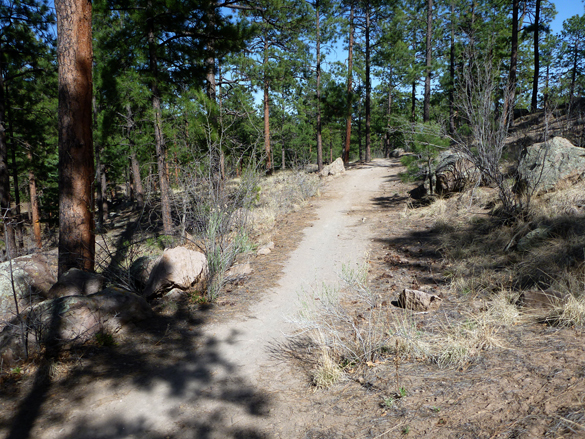 The top of Bayo Canyon Trail. Photo by Bruce Warren
The top of Bayo Canyon Trail. Photo by Bruce Warren
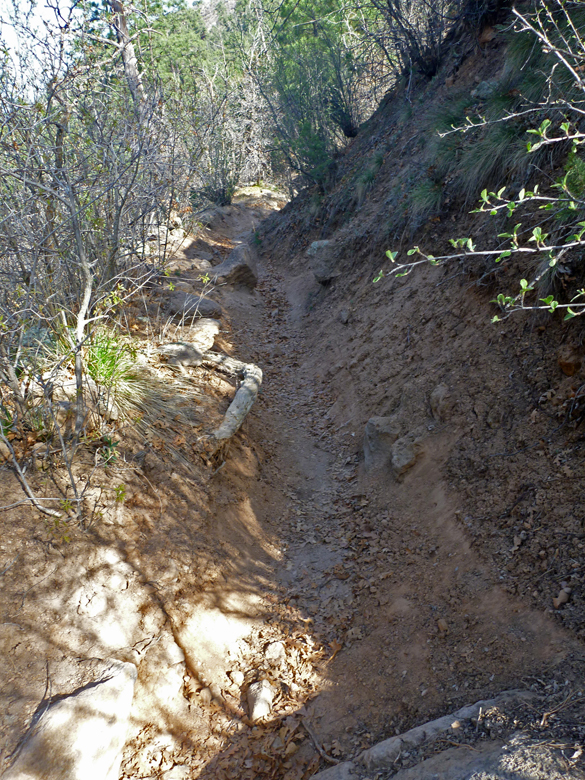 The steep, narrow part of Bayo Canyon Trail. Photo by Bruce Warren
The steep, narrow part of Bayo Canyon Trail. Photo by Bruce Warren
The Walnut Canyon/Pueblo Canyon route presents even more difficulties, with a very steep descent into the bottom of the canyon, and cliffs on all sides. Ledges would have to be cut into cliffs and a lot of earth moved to accomplish the necessary grade and large-radius turns.
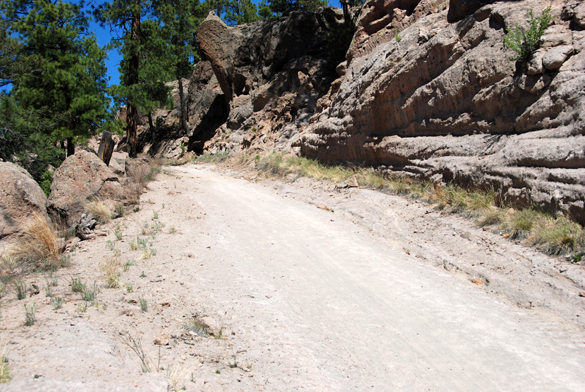 The steep part at the top of Walnut Canyon Road where it drops down from the Golf Course. Photo by Bruce Warren
The steep part at the top of Walnut Canyon Road where it drops down from the Golf Course. Photo by Bruce Warren
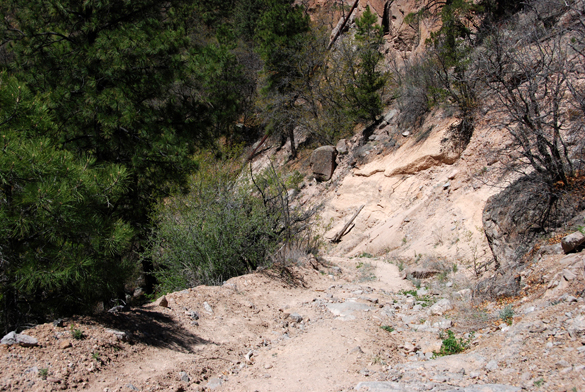 The steep part of Walnut Canyon Road where it drops into the bottom of Pueblo Canyon. These steep bits look a lot steeper on a bicycle than they do in photographs.] Photo by Bruce Warren
The steep part of Walnut Canyon Road where it drops into the bottom of Pueblo Canyon. These steep bits look a lot steeper on a bicycle than they do in photographs.] Photo by Bruce Warren
JUSTIFICATIONS GIVEN FOR A FLOW TRAIL
As with many projects in this county, this one followed a path not particularly visible to the public. These projects often start with a small group of people (in this case a certain type of bicyclist) that wants something (in this case a flow trail). They approach members of the County governance waving the flag of “economic benefit” to the County, and the ball starts rolling. For more insight to the evolution of this idea, see the Los Alamos Monitor article of Oct. 28, 2016, (link).
According to a member of the Parks and Recreation board, there were meetings with what he called “stakeholders”. You would think this includes anyone who uses our trails or anyone living in proximity to them, but no, the only “stakeholders” at these meetings were the very bicyclists who want a flow trail. So why do these folks want a flow trail? Some of the reasons given at the meeting (and my personal responses to them) were:
- It would be fun. No doubt for some people, but flow trails aren’t every bicyclist’s cup of tea. Some of us like trails with challenges in the form of rocks and other obstacles.
- It would be “family friendly”. This is assuming that everyone on the trail will coast down it, but we all know that the kids and newbies might be rolling along, but the expert bikers will be barreling down the trail at full tilt so they can take advantage of all those jumps and banked turns. That doesn’t sound like a very family friendly mix to me.
- We need a place to teach kids how to mountain bike. This person complained there are only two suitable trails existing for teaching kids to ride mountain bikes. That’s two more than most any other community. It seems to me that a flow trail doesn’t really offer much in the way of features that would teach kids the skills needed for mountain biking in a natural environment in any case.
- It will put our town on the map and make lots of money for the County and local businesses. Haven’t we heard this kind of thing before? See the next section on costs and benefits.
COSTS AND BENEFITS
In what seems to be a consistent pattern for the governance of Los Alamos County, I believe that the Council and staff have underestimated the cost of a project of this magnitude and overestimated the economic benefits. As I’ve said, I’m not an engineer, but I have enough science background and some experience with hiring contractors with earth-moving equipment when I built my house to see the absurdity of thinking you could build the proposed trail down Bayo Canyon, say, for $50,000. The engineering fees alone would eat up most of that. The existing Bayo Canyon Trail is about 6 miles long. I’d be surprised if you could even construct a single mile of that trail in the difficult section for $50,000. And to think of a flow trail from the top of Pajarito Ski Area, all the way down to the sewage plant? I’m pretty sure $500,000 wouldn’t go far on a project of that magnitude, estimated at 30 miles of trail.
Construction of the trail is only the beginning. For the trail be successful it would need a shuttle service from the bottom of the trail. If the County supplies that, that would be an on-going additional cost. Then there is maintenance, something our County is pretty abysmal at. It’s so much more fun for County governance and staff to build things than to maintain and repair what we have. Erosion is a serious concern on our trails, and would be especially so for a flow trail, which is supposed to have a smooth even surface. If the County’s record for maintaining our current trail system is any example, I wouldn’t hold out much hope for a new trail to be kept in good condition.
As far as the benefits, as is often the case in this county, no data or surveys were offered to validate the claims of all the money that would come in as a result of this project. Instead, other areas that have constructed flow trails and claim to be making money off of them were cited. Purgatory ski area and Angel Fire ski area were mentioned as proof that money can be made from flow trails. In fact these were established destination resorts long before flow trails were built there, and these trails are lift-serviced. Moab was also mentioned as a place that makes a lot of money from mountain biking. Los Alamos is not a destination resort, and the addition of one resort-type recreational facility is unlikely to turn it into one. And do we even want our town to be a resort? See the next section for more on that.
EFFECTS ON ENVIRONMENT AND LIFESTYLE
I think anyone can see from the above description the enormous impact construction of a flow trail would have on our canyons. Los Alamos appears to be unique in its possession of an amazing network of single-track, hand-built, multi-use trails right in the middle of town. Nearly any resident can be in a beautiful natural environment either right out their back door, or with only a walk or ride of a few minutes. Do we really want to damage this environment and natural experience for the sake of attracting a few bicyclists to our town? Walnut Canyon is one of our prettiest and quietest canyons.
 Walnut Canyon from the North Rim. Photo by Bruce Warren
Walnut Canyon from the North Rim. Photo by Bruce Warren
 The bottom of Walnut Canyon. Photo by Bruce Warren
The bottom of Walnut Canyon. Photo by Bruce Warren
Why would we want to bulldoze a trail of this type through that lovely environment? The same is true of Bayo Canyon, with a beautiful quiet experience. And what about homeowners who bought their houses on the canyon rims for the beauty, peace and quiet? Do we want our town to turn into Moab? Moab used to be a small, quiet desert town. The last time I was there it was crammed with adrenaline junkies looking for their next fix, and with chain hotels proliferating everywhere. Is that what we want for Los Alamos?
MULTI-USER TRAILS VS SINGLE-USER TRAILS
The current network of trails in and near Los Alamos are nearly all multi-user trails, meaning that anyone can enjoy them walking or biking. This system works very well because nearly all trail users exercise good sense in navigating the trails with concern for the safety of others using the trails. Building a single-use trail (in this case for bicyclists only) sets a bad precedent and encourages the proliferation of trails in our canyons to serve various interest groups.
LIABILITY ISSUES
There is a big difference between the liability issues associated with our current trail system and those of a flow trail. Our current trails mostly follow the contour of the land and any obstacles in them were placed there by nature. If someone falls off a rock while hiking or biking this type of trail, it is pretty hard for them to bring justifiable suit against the County. If, on the other hand, the County builds an engineered trail with features encouraging jumping and other such feats, they are opening us up to liability for injuries due to faulty design. This is especially true if the County advertises and promotes the flow trail as a recreational facility.
HISTORICAL VALUE
If all the above isn’t enough to convince you that a bicycle flow trail in the Los Alamos canyons is a bad idea, consider the fact that the Bayo Canyon trail follows the route of the old Bayo Road. This was a road from homesteader days and you can see the wagon wheel ruts worn and eroded into the bedrock on the trail. The Bayo road retains the only narrow wagon wheel ruts in the Los Alamos area (see the photo on the next page). Bayo Road is on the National Register of Historic Places, and as such should not be disturbed. See the registration at: https://www.google.com/url?sa=t&rct=j&q=&esrc=s&source=web&cd=1&ved=0ahUKEwj3ory9yrvTAhVN32MKHX-uCLIQFggkMAA&url=http://focus.nps.gov/GetAsset?assetID=68e7949b-edb3-4230-a463-d5c483409d88&usg=AFQjCNEfHSEWdP_d_KpA9lOkTj9KjZeSoA
I’ve been told that the County staff was aware of the historical status of this route when they laid out the flow trail route, and that the new trail would not be on top of the current trail and would only cross it in one place. But part of a historical designation is not only the feature itself, but also the environment the visitor finds it in. As you walk the trail today, it easy to imagine the feeling of the area as the homesteaders on the Pajarito Plateau saw it more than a century ago, but that experience would be greatly changed if mountain bikers were whizzing past you on an adjacent trail.
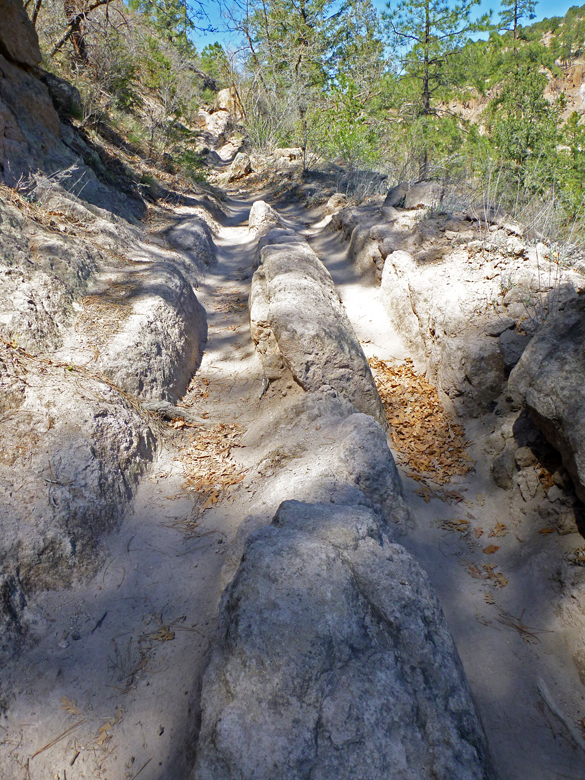 Historic homesteader wagon ruts on the Bayo Canyon Trail. Photo by Bruce Warren
Historic homesteader wagon ruts on the Bayo Canyon Trail. Photo by Bruce Warren
A BETTER PLACE FOR A FLOW TRAIL
If the County thinks a flow trail is such a great idea, let them put it on the Pajarito Mountain Ski Area. This is already a resort-type area, and the trail could be lift-served. I’ve been told that a flow trail was laid out there, and that it was a very feasible idea. When this was proposed at the meeting, one person complained that the lift doesn’t run all the time and that it costs money to ride. Last time I checked, I didn’t find that bicyclists looking for this kind of experience were entitled to enjoy it at any time they pleased and at tax-payers’ expense. If the flow trail attracts all the people its supporters claim it will, the ski hill would quickly find it in their interest to expand the non-winter lift hours. In fact, Pajarito Ski Area just came out with a great offer of unlimited summer lift rides with your bicycle at Pajarito and Purgatory for just $149.

